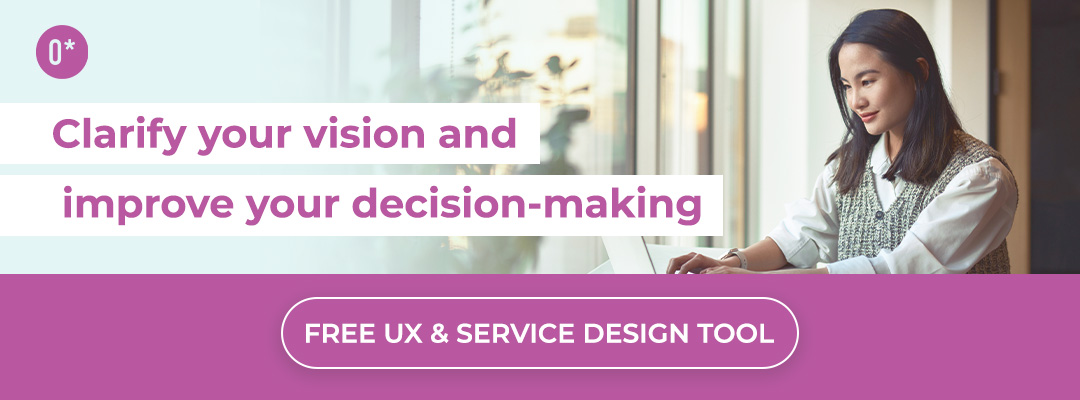Identifying and solving business challenges can be really difficult for organizations, big or small, and managers usually turn to their business experts, marketing teams, or IT teams (among others) to figure out muddy internal processes, bad user experience, or poor company culture. But…what about the design team? Many people don’t realize that designers are actually trained to solve problems using tried and true processes. Frankly, they just think differently about challenges and how to fix them.
As designers, we (at Outwitly) actually see this all the time: a build up of team frustration because priorities are seemingly always changing and decisions are constantly being made “by committee.” This leads to constant revisions, the unsettling feeling that everything is up for debate, and a general lack of alignment between teams, stakeholders, and execs. This lack of strategy and clear vision then leaks into the customer or user’s experience, which starts to feel inconsistent and disjointed. It’s not an easy fix.
But if you have UX and/or service designers already on your team––then you’re actually one step ahead! Designers are great assets for organizations seeking to streamline clunky internal processes, improve employee culture, or develop a long-term company vision. In fact, the field of design has an entire approach dedicated to doing just that: Design Strategy.
What is Design Strategy?
Design Strategy combines design thinking and business strategy to help teams craft a “strategic” mindset and build solutions to overcome obstacles (like some of the issues we listed above). Using ethnographic research methods, storytelling, and creative problem-solving techniques, design strategists (or UX designers and service designers) can help teams and stakeholders tackle these complex issues.
In fact, common business challenges can be drastically improved when observed through a human-centered design lens. This might include inefficient and/or manual internal processes, poor company culture and frustrated teams, “messy” digital tools that overlap and that no one knows how to use, a lack of vision or stakeholder alignment, poor brand positioning, and much more.
This is where design strategy can play a major role. Design strategy really looks at the intersection between business needs and goals, the user’s wants/desires, and what is feasible from a resource or technology standpoint (see Venn diagram below). Designers can do so much more than make things look pretty (that’s really only a small part of what we can do!), and a design strategist’s job is to understand all sides of the issue by talking to the people involved and revealing their real needs and wants.
View this post on Instagram
Click through for more…
Ultimately, businesses are made up of people. So if you want to change and offer amazing customer experiences, for example, it really depends on the people at your organization. In design strategy, listening to teams, stakeholders, and users––and really seeing them and hearing what they want and need––is so, so important. Designers often play the role of a neutral third-party or “therapist.” We try to diagnose problems by understanding and listening to people. Then, once we’ve heard all sides (including what the business needs are, what users want, how employees feel, what’s stopping change, and so on), we weigh all the perspectives and use our design skills to ideate and brainstorm creative solutions––solutions that others might not have thought of.
Likewise, designers approach every new challenge with a “beginner’s mindset”, or as a novice might. Since we (also, initially) don’t know what’s working and what’s not, we can bring a fresh perspective to any business challenge to break down barriers and uncover new connections and solutions. We are also skilled at bringing in ideas and solutions from other industries, and adapting them to the issues at hand.
At a high level, then, design strategists are trained to:
-
Constantly identify problems, and
-
Imagine a better way of doing things through creativity and ideation!
So applying design strategy to your business will almost certainly include elements of:
-
Multi-disciplinary collaboration (cross-departmental, across industries, and more).
-
Ideation––exploring many possible solutions and ideas to address a problem.
-
Creativity––finding novel ways to do things without initially worrying about whether it “can be done.”
-
Iteration––trying and adjusting until we hit the mark (designers aren’t afraid to see an idea fail!)
-
A human-centered focus––concentrating on the people involved, whether that’s execs, employees, or end-users.
Remember, it’s really important (and easy!) to take advantage of your design team’s inherent strategic skills. As we hinted above, designers have a natural advantage when it comes to being strategic players on a team or at an organization. Designers are:
-
Multi-disciplinary. Service and UX designers typically engage with multiple departments in order to do their job. They are used to networking and building connections within an organization, and are constantly thinking about why and how the business functions. Seeking out pain points and new opportunities for strategic innovation is really a designer’s bread and butter.
-
Visual storytellers. This is a major component of how designers communicate their findings, insights, and design work (with tools like Customer Journey Maps, Insights reports, or Personas, for example). When it comes to making strategic changes and decisions, designers are skilled at helping people clearly understand (through visual storytelling) why change is important, as well as how to effect change.
-
Creative problem solvers and design thinkers. In design school, these skills are taught on Day One. This includes methods and new ways of thinking that can be applied to business problems. For example, designers are taught how to build empathy, how to conduct discovery research (like in-depth interviews, contextual observations, and diary studies), and how to conceptualize new solutions––all of which lead to innovation and can therefore provide huge competitive advantage for businesses.
-
Excellent facilitators. With expertise in bringing people together to work out a problem, most designers can plan and facilitate co-design workshops with diverse stakeholders and teams. They know how to manage different opinions and perspectives, and actually move forward without getting stuck on one thing.
Getting Started with Design Strategy
If you don’t have designers on your team (and even if you do, but you’d like some initial direction), here are three ways to get started with Design Strategy:
-
Assess your organization’s UX Maturity and/or Design Maturity. This is a framework that can allow an organization to identify and categorize the quality and effectiveness of its design and UX practices. The Design Management Institute has a great assessment tool for organizations that you can download for free here. Maybe your company has never really engaged in or used UX research or design-thinking techniques (this would indicate Low Maturity). On the other hand, you may already have an entire design team at the ready, and a strong understanding of design’s intrinsic business value (this would indicate High Maturity). Or, maybe your company falls somewhere in the middle! If your organization already values design and research, an incoming designer will be well-positioned to have a strategic business impact and to facilitate strategic conversations with your team and stakeholders.
-
Gain Stakeholder Buy-In. This is huge. If your company has Low UX Maturity, you might need to spend some time researching the value of design and educating management before you can take the next step. Ultimately, to have impact, you need to get stakeholders and employees to believe in what the company is doing or trying to change. Remember, you are not alone: designers can also think of creative ways to help you gain stakeholder buy-in through strategic alignment workshops, helping to champion the value of design, and by applying many other great design strategy techniques.
-
Invite your designers to participate in higher-level strategic conversations. Now that you understand how design strategy can help––and after you’ve gained buy-in––take a leap of faith, and ask your design team what their thoughts are about some of your main business challenges. Plan a meeting to tackle these questions, and invite your designers to participate alongside management and/or people from other departments. Better yet: explain your issues to the design team and give them elbow room to organize a workshop or brainstorming session!
We’ve spoken before about how wise it is to hire external UX and design consultants for your project or organization, and Design Strategy is no different (even if we are a little biased, as a design consulting firm…) There are innumerable ways forward if you’re looking to strengthen your organization’s decision-making and tackle major business problems––involving your service and UX designers in the conversation is an important first step.
Want to learn more about applying Design Strategy & Human-Centered Design to tackle tough challenges?





